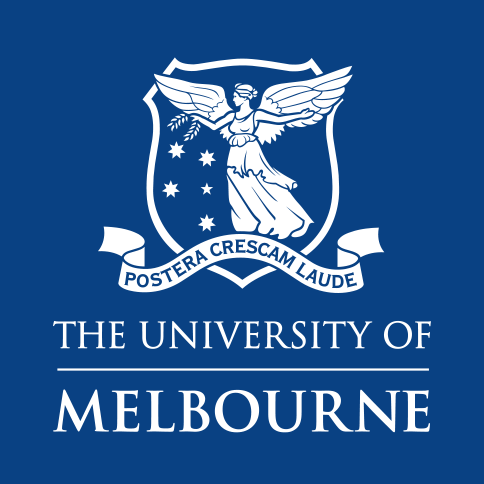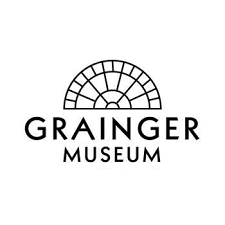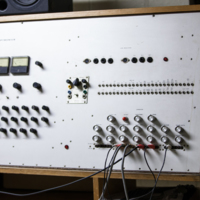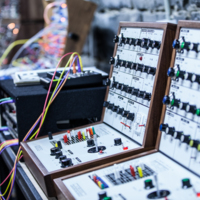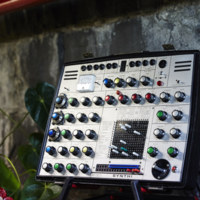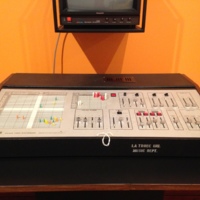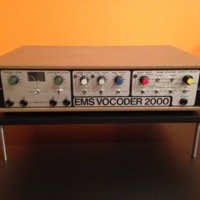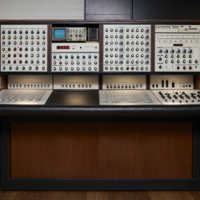EMS Instruments at the Grainger
The first electronic instruments brought into the Grainger Museum were privately owned by Keith Humble, purchased from the EMS company. The first instruments owned by Humble include the EMS VCS1 and VCS3 on display in the exhibition Synthesizers: Sound of the Future.
In 1972, a Gulbenkian Foundation grant provided funds for the purchase of a full suite of EMS instruments for the Grainger Electronic Music Studio. These instruments included a VCS3 MK1, VCS3 MKII, Synthi AKS (which included a keyboard) and the EMS Synthi 100. The EMS Synthi 100 was by far the largest instrument in the Grainger studio, and the culmination of the EMS Synthi series. Other equipment purchased by the grant included an Optro 1” 8-track tape recorder and Optro 7500 12-8 mixing console.
Keith Humble wrote of the creation of the Grainger studio:
The best way that I can explain it is that the Vice Chancellor at Melbourne University in those days had … a tradition that they would always invite you to afternoon tea when you were first appointed. [D]uring the course of afternoon tea, the Vice Chancellor said: ‘I believe you came here to develop an “electronic studio”’, and I said ‘Yes!’ He said: ‘I’ve got one at home and they’re very good, aren’t they?’ I realised that what he was talking about and what he was thinking of, was a hi-fi set! ... So it became a battle which was years later repeated at Latrobe: educating people that—no! You didn’t want one thousand dollars, but you wanted one hundred and fifty thousand dollars! … What was important was: by opening the Grainger Museum, one already had a tradition in electronic music to build upon. I could say: ‘here is the man [Percy Grainger], now if that has already been accomplished, you have to put up’—that was a way of illustrating it.
ELECTRONIC MUSIC STUDIOS, LONDON
Comprising of pioneering electronic musicians Peter Zinovieff and Tristram Cary (famed for his work on the Dr Who series) and engineer David Cockerell, EMS’s London studio was one of the most advanced computer-music facilities in the world. The EMS studio, established in the early 1960s, produced some of the very earliest analogue synthesizers, and played a huge role in popularising the instrument and electronic sound.
EMS synthesizers were created with the ideology of post-war Modernism and the avant-garde in mind. Creating new music from the raw materials of sound and improvisation were central to the purpose of these synthesizers. The lack of a traditional keyboard to interact with the instrument is an integral feature. There is no easy way of producing sequences of distinct pitches, or notes. Cary said of the early EMS VCS instruments “the whole thing about electronic music for me was you were getting away from keyboards, one thing you wanted to avoid in electronic music was 12 notes to the octave”.
The original market for the analogue synthesizers was contemporary experimental composers. However, the synthesizer came to be associated more and more with popular music between from the early 1970s. Groups like Pink Floyd and Roxy Music were attracted to electronic music through a cross-pollination of ideas with the innovators at EMS. The VCS3 changed the sound palette available to mainstream rock bands.
EMS incurred burdening debts through the late ‘70s, and collapsed as a company in 1979. The instruments that had been made, and sent around the world to studios and artists, gradually fell out of use, as digital synthesizer production overtook the analogue antecedents. However, in recent years interest in EMS and particularly the VCS3 has grown to cult proportions and its products have become rare collectors’ items.
